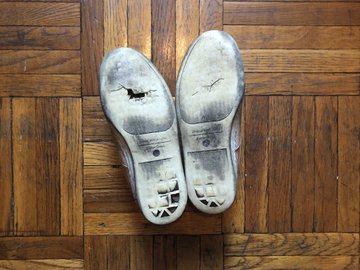Democrats Ignore the Left at Their Peril; They Had Money, We Had People - How Ocasio-Cortez Persuaded Thousands

Democrats ignore the left at their peril. Midwesterners aren't scared of socialism — they're hungry for it. - Carlos Ramirez-Rosa (NBCNews.com)
They Had Money, We Had People - Miriam Bensman (Dissent)
By Carlos Ramirez-Rosa
July 9, 2018
NBCNews.com
Listen here.
In a recent interview on CNN, Sen. Tammy Duckworth, D-Ill., claimed that candidates who push policies "too far to the left" won’t be able to win in Midwestern states. It’s an idea that many Democrats have returned to in the wake of surprises like democratic socialist Alexandria Ocasio-Cortez’s New York primary victory in June. The theory is that more bold, left-wing ideas might appeal to some voters on the coasts, but average folks in the heartland aren’t interested in scary ideas like socialism.
While this argument may comfort mainstream liberals, it’s not one that reflects the history — or the present — of socialism in the Midwest.
From the workers’ struggles in the 19th and 20th centuries thatwon the eight-hour workday to the growth of a fighting labor movement to my own election as a millennial socialist city council member in Chicago, Midwesterners have consistently backed socialist movements and socialist candidates that reject the political status quo and fight for the working-class values of solidarity and equality.
Indeed, despite what Duckworth or anyone else might think, socialists have a long history in this region. Eugene Debs, whose labor and political activism in the around the turn of the 20th century made him the most important socialist organizer in American history (and one of Bernie Sanders’ icons), is from Terre Haute, Indiana. “Sewer socialists” governed Milwaukee and other areas of Wisconsin for decades, including Victor L. Berger, who in 1910 was elected to the House of Representatives — the same position Ocasio-Cortez is on the verge of winning this November.
Midwestern cities and towns such as Dayton, Ohio, Minneapolis, Minnesota and Flint, Michigan, all have proud socialist backgrounds. “Appeal to Reason,” the most widely read socialist publication in U.S. history, was published out on the plains of Girard, Kansas; Oklahoma was a national hotbed for Socialist Party organizing for much of the 20th century’s first half.
The Midwest has also been home to militant worker organizing for over a century, from the Haymarket massacre in Chicago that sparked the modern American labor movement as we know it, to theFlint sit-down strikes of the 1936-1937 which upended the U.S. auto industry, to the founding of public-sector unionism out of Wisconsinin the 1950s, to more recent fights like the Chicago Teachers Union’s 2012 strike.
Far from being allergic to socialism and class struggle, as Duckworth suggests, the Midwest has always been a region steeped in it — even leading the way.
This isn’t all ancient history, either. In the most recent Democratic presidential primary, Sen. Bernie Sanders — for whom I was a proud delegate to the Democratic National Convention — ran an unapologetically left-wing campaign, proudly fighting for popular policies like Medicare for all, a $15 minimum wage and free public college, all while proclaiming himself a “democratic socialist.”
Were Midwesterners scared off by his clear embrace of socialist ideas? Far from it. Sanders won primaries throughout the Midwest, in states like Wisconsin, Minnesota, Michigan and Indiana and barely lost in Iowa, Missouri and Illinois.
And look at my own election. I’m a 29-year-old member of the Democratic Socialists of America (DSA) who was elected to the Chicago City Council in 2015. I ran on an unabashed platform of fighting for this city’s working class: fully funding public schools, opposing privatization, ending corporate welfare, preserving and expanding affordable housing and reopening shuttered health clinics. And I wasn’t afraid to call out the corporate-friendly Democrats who continue to cut vital social services while giving handouts to corporations and the wealthy.
Did this bold political vision make voters skittish? No way. They chose it in a landslide: Sixty-seven percent of voters in the 35th Ward on Chicago’s northwest side voted for me.
The same has been true outside of major urban areas as well. Last year, in Rock Island, Illinois, millennial diesel mechanic and democratic socialist Dylan Parker won election to the city council on a broad platform for the many and not the few that included equitable economic development and universal broadband internet access.
Indeed, this hunger for anti-corporate, anti-establishment politics is spreading throughout the Midwest. You can see it in the massive growth of the Democratic Socialists of America — currently boasting over 44,000 members. Ocasio-Cortez and I are both members of DSA, which has seen chapters spring up everywhere from Indianapolis and Cincinnati to Des Moines, Iowa and Michigan’s Upper Peninsula. My own chapter in Chicago now has over 1,500 members.
The Democratic establishment may not want to acknowledge the growing popularity of the party’s left flank and its agenda of fighting for real social, racial and economic justice. But if they hope to win, it’s time they embrace it. If they don’t, we’ll take them head-on.
Midwesterners aren’t a monolith, demographically or politically, and we're also not scared of bold left-wing policies — in fact, we're hungry for them. That vision is firmly rooted in the Midwest’s past. It’s also our future.
[Carlos Ramirez-Rosa has served as alderman of Chicago’s 35th Ward since his election to the City Council in 2015. Queer, Latinx and a democratic socialist, Ramirez-Rosa served as a deportation defense organizer prior to his election and was an elected Bernie Sanders delegate in 2016. He was named an “emerging power player” by Chicago Magazine in 2017.]
A dedicated team of volunteers persuaded thousands of new voters to support Alexandria Ocasio-Cortez—and transform the Democratic Party in the process.
By Miriam Bensman
July 9, 2018
Dissent Magazine Blog
Three women in brightly colored saris were heading my way. It was primary day in New York’s 14th congressional district, and I was in Woodside, Queens handing out glossy yellow cards for Alexandria Ocasio-Cortez. Swerving off course to take one each, the women smiled in recognition of the young Latina candidate’s face and went into a school to vote.
There’s a simple lesson in the improbable victory of Alexandria Ocasio-Cortez, a twenty-eight-year-old Bronx Latina and self-described democratic socialist, over U.S. Rep. Joe Crowley, a ten-term incumbent twice her age: voters respond if you reach out to them. Old-fashioned shoe-leather politics can work wonders, if the campaign has a compelling message and aims beyond so-called “prime voters” to expand the electorate.
The candidate said it best on Twitter:
Alexandria Ocasio-Cortez✔@Ocasio2018
Some folks are saying I won for “demographic” reasons.
1st of all, that’s false. We won w/voters of all kinds.
2nd, here’s my 1st pair of campaign shoes. I knocked doors until rainwater came through my soles.
Respect the hustle. We won bc we out-worked the competition. Period.
Crowley was too complacent to do the work, both out of practice and out of touch. His flyers and TV ads were bland, and indistinguishable from the ones Democratic incumbents were airing across the nation. Fourteen years without a primary and with only token opposition in general elections had turned political muscle to flab. Crowley might be Chairman of the Queens County Democratic Committee, but he didn’t have many people out talking to potential voters in a district that spans northern Queens and the east Bronx, or listening to their concerns. The much-feared Democratic machine, it turned out, was a paper tiger.
I first encountered Ocasio-Cortez in March at a Democratic Socialists of America (DSA) endorsement meeting. She had recently joined the organization and seemed smart, down-to-earth, and passionate about economic and social justice. The charisma that has wowed TV interviewers and the nation since her victory wasn’t yet in full flower, but like Bernie Sanders, she moved me.
I didn’t think she could win, but at the least, we could give Crowley a scare and lay the groundwork for a future victory. I didn’t wait for the endorsement; I signed up through the Justice Democrats website to volunteer.
The first task was to gather petition signatures to get Ocasio-Cortez on the ballot. On the first warm Saturday in April, I joined half a dozen volunteers in Sunnyside, Queens, where residents were heading to the Greenmarket. The low-rise neighborhood doesn’t bustle, but there were plenty of people willing to talk.
Eco-conscious millennials bringing kitchen scraps for composting were easy targets. They hated Crowley because he’s the local machine boss raking in contributions from real estate interests and Wall Street. A few had heard of Alexandria, as we called her, and approved of her pledge not to take corporate donations. I gathered nineteen signatures in a couple of hours.
It was harder the next weekend on Queens Boulevard, near the Sunnyside Arch. There were more long-time Crowley supporters. But a pattern emerged: women of all ages and ethnicities were eager to sign. I collected another twenty that day.
Ultimately, the Ocasio campaign turned in more than 5,000 signatures; Crowley’s paid petitioners gathered a similar amount. Though Ocasio-Cortez’s viral video prompted a late surge of contributions, Crowley would outspend her ten to one over the course of the campaign. But where they had money, we had people.
For at least three decades, sophisticated primary election campaigns have focused on “prime voters,” people who voted in the last few primary races. This is efficient: The campaign only has to persuade and turn out a manageable number of likely voters. But the strategy contributes to a withering of the voter base by contacting only the most engaged.
The Ocasio campaign took a different tack: It tried to reach every registered Democrat in person and by phone. This is not efficient, but it may be the only way to score an upset in districts like NY-14, where primaries are rare, the population has changed dramatically, and there are many young people and working-class people of color, who tend to move often. Such districts have few prime voters; they have few voters overall. In 2016, only 178,000 people voted in the general election for congress in NY-14; few districts nationally had a lower total. The Ocasio campaign expected only 15,000 people to vote in the primary; bringing out 2,000 to 3,000 unexpected voters could spell victory. The final vote count was over 25,000.
Volunteers from DSA and other organizations spent months going door-to-door to reach those extra voters. At first it was difficult. The few people at home wouldn’t open their doors. But as the campaign gained visibility and volunteers gained skill, canvassing became more productive. Given a turf of eighty homes, I might reach ten to twenty people in two hours. On a good day, five would promise to vote for Alexandria; on a great day, ten. Carefully entered into the campaign’s mobile app, these numbers added up. By primary day, the Ocasio campaign knocked on more than 120,000 doors, made more than 170,000 phone calls, and sent over 175,000 texts to voters in the district, according to campaign spokesperson Corbin Trent. During the get-out-the-vote effort over the final four days, we had nearly 20,000 conversations in person, and by phone and text.
There’s nothing like the feel for a district a candidate and campaign gain from walking door to door, seeing the varied housing stock and shops, and talking to people whose opinions are seldom asked.
“You want talk me?” an eighty-seven-year-old woman in Astoria asked. As I fumbled for the bilingual literature she hobbled inside with her cane and returned with a camp stool. “She Spanish?” she asked, sitting down for a chat. “Sí, puertorriqueña.” She carefully studied the flyer.
“I vote for the Democrat,” a man in an Elmhurst apartment house said. I explained that this year we could choose which Democrat to run against the Republican. He paused. This was a novel idea.
A young father said it was a bad time—they were putting the baby to bed—but his wife came out to talk, babe in arms. She liked the sound of Medicare for All and of free tuition at public universities and trade schools.
Five women were chatting gaily in Spanish in a tiny Woodside parlor when I knocked on the open door. They nodded seriously when I told them Ocasio-Cortez wanted more affordable housing, to help rebuild Puerto Rico, and to abolish ICE. They said they’d go out to vote together.
In a district packed with immigrants from around the world, the few Crowley supporters I met were mostly white and seemingly U.S. born. But in Woodside, a black woman with grey hair told me crisply, “We’re for Crowley,” and shut her door.
Most often, voters said they were undecided. Many people didn’t know there was an election in June, because TV and newspaper coverage of the campaign was scarce until the final couple of weeks. If they didn’t want to hear my spiel, I’d suggest they search online for the June 15 NY1 debate.
“I’m getting a good feeling about this primary election,” I posted on Facebook after hours of handing palm cards to receptive voters on primary day. The results were still shocking. Not long after I reached Ocasio-Cortez’s election-night party at a billiard hall in the Bronx, the AP called the election. She had beaten Crowley 57.5 to 42.5 percent. No one expected such a margin, least of all the candidate.
The crowd that night was as diverse as the district ethnically, but decidedly young. At nearly sixty, I was an outlier. Ocasio-Cortez had attracted a brigade of young people like herself, who had come of age during the 2008 financial crisis, had difficulty getting their careers on track, and were burdened by student loans.
They were veterans of Occupy Wall Street and the Bernie Sanders campaign; activists in the Movement for Black Lives, Indivisible, Justice Democrats, Brand New Congress, Bronx Progressives, and DSA; members of local churches and Jewish, Hindu, and Muslim community groups. Many found the campaign online and contributed to a lively social media campaign.
We had climbed thousands of stairs, trudged door to door in the rain, and sat elbow to elbow, calling voters on our own phones, not expecting to win. We succeeded beyond our dreams, slaying the paper tiger with shoe leather.
[Miriam Bensman is a freelance writer in New York City.]



